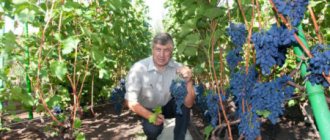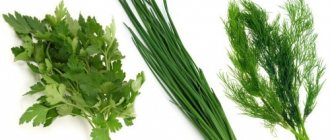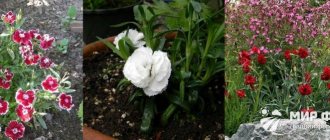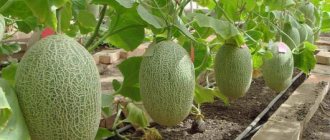Pros of growing in a greenhouse
Cultivating a crop in protected soil has many advantages. When growing in a greenhouse, you don’t have to worry that the grapes won’t have time to ripen before the cold weather sets in, because the climate in the greenhouse can be controlled independently. In addition, even in the south, many winegrowers prefer to grow berries indoors, because this way they can get the harvest much earlier than expected. This is especially true for those farmers who are engaged in entrepreneurial activities and grow grapes for sale. The advantages of greenhouse cultivation also include:
- No problems with harmful insects and diseases - any living creatures rarely enter the greenhouse, including wasps, which often spoil the berries. Diseases such as mildew and oidium appear extremely rarely in greenhouses.
- Plants are protected from adverse weather conditions, be it rain, wind or sun. Grapes grow and develop in static climatic conditions.
- The growing technology is simple. Plant care is convenient. There is no need to additionally treat the bushes with fungicides and insecticides.
- The berries do not crack from precipitation, and the brushes do not fall apart from windy gusts. This allows the gardener to harvest a full harvest in full.
- The taste of the fruit remains at the same level, in no way inferior to ground grapes.
Pest treatment
One of the main tasks of a gardener in the spring is treating the vineyard from pests. Carrying out a number of preventive works is much easier than further treatment of bushes.
A set of preventive measures
The complex of measures for preventive treatment of grapes includes the following stages:
- Initial treatment of the plant after removing the cover and before the buds begin to bloom. Usually a solution of copper sulfate is used for this. One of the options for the first spring treatment of grapes against pests is presented in the following video: Secondary treatment is carried out after the first leaves appear. This is approximately the first week of May. Treat the bushes with Horus, which prevents the appearance of pests and various diseases.
- It is recommended to carry out prophylaxis against ticks with the drug "Sunmite". This is done in the first week of May.
- A week before the grapes begin to bloom, they are treated with a special mixture of insecticides “Decis”, “Ridomil”, “Topaz”.
- The plant is also treated with similar preparations during the period of mass flowering.
It is recommended to carry out all procedures in the morning, following the instructions indicated on the drug packaging.
Pests and methods of controlling them
Depending on what pest is attacking your vineyard, you can choose one or another method of combating it:
- Phylloxera. This is a small insect that damages the root of the plant. The disease is characterized by swelling of the roots, where pest colonies are located. The disease begins with rotting of the tissue, as a result of which the root system dies and the bush dies. To combat pests, a cork layer of protection is used.
- Khrushchi. The most harmful beetles for grapes are:
- marble;
- Transcaucasian
May;
The most common species in spring is the cockchafer. It spreads larvae that develop in the soil and gnaw through roots and cuttings in the plant. When digging the soil, the gardener needs to carefully collect and then destroy them.
Grape diseases
In addition to pests, the vineyard is threatened by the following diseases:
- Mildew is a disease that affects all green leaves and berries. This is a kind of fungus that reproduces in conditions of high humidity. Methods to combat this disease are timely mulching and the application of phosphorus and potassium fertilizers. The drugs “Bordeaux mixture”, “Strobe”, “Chorus” are also used.
- Oidium appears as a grayish-white dust on the leaves and stems of the plant. The inflorescences look as if they were sprinkled with flour. This fungus develops in damp and moderately warm weather in poorly ventilated places. The plant requires complex treatment with Thanos, Horus and Thiovit.
- Gray mold often affects grafting sites. The fungus settles on just beginning shoots, causing them to die. The plant is treated with fungicides that prevent the spread of the disease. They also use similar remedies as for mildew and oidium.
Variety selection
Almost all varieties are suitable for greenhouse cultivation, but the best productivity is shown by those that have early ripening periods. For the first time, it is preferable to select cold-resistant, highly immune, shade-tolerant varieties that are guaranteed to produce good offspring. Considering the size and height of the greenhouse, it is recommended to give priority to medium-sized and weakly branched varieties.
Table of varieties most suitable for greenhouses:
| Variety name | Growing season | a brief description of |
| Laura | 110-115 days | High yield. Large berries. Great taste. The mass of the bunch is up to 2.5 kilograms. |
| Song (White Miracle) | 110-115 days | The berries are large, with a large proportion of sugar. The color of the fruit is light green. |
| Greenhouse black | 115-125 days | Self-pollinating variety. The taste of the berries is mediocre. Low resistance to fungal diseases. |
| Memory of Dombkowska | 155 days | High-yielding. Has high immunity. Frost-resistant. |
| Arcadia | 115-125 days | Productivity is above average. Cold-resistant down to -21 degrees. Not susceptible to mildew. Compatible with many rootstocks. |
| Moscow sustainable | 130-140 days | Frost-resistant variety (up to -25 degrees). Possesses enviable health. The berries taste good. |
| Russian Korinka | 110-120 days | Vigorous bush. Resistant to mildew, often affected by oidium. Tolerates frosts down to -28 degrees. |
Tips and reviews from experienced winegrowers
A greenhouse is a definite guarantee that you will reap a good harvest even in unfavorable years. And you can even grow very early varieties indoors and harvest up to 5 kg of harvest from one bush. The greenhouse area can and even should be used as rationally as possible - since the rows are free, they are sown with herbs, radishes, strawberries, onions or garlic.
Experts do not recommend covering the greenhouse with polyethylene, since the material is not able to maintain indoor conditions that are comfortable for plants.
A well-designed, reliable greenhouse is an important condition for successful grape growing. For a vineyard, a greenhouse must have the following parameters:
- convenient approach to plants;
- presence of a ventilation system;
- space corresponding to the size of the bushes;
- sufficient thermal insulation;
- strength.
For good development, the bushes need to be pinched; they do this 2-3 times a season - remove weak, extra shoots, leaving the strongest ones with a large number of inflorescences. It is also recommended to thin out the bunches to ensure large berries.
Greenhouse requirements
In a properly equipped greenhouse, all phases of the growing season of a grape plant pass much faster than in open ground, on average by two weeks. Grapes can be grown in unheated and heated greenhouses. In the first case, the harvest can be obtained 3 weeks earlier than usual, in the second - a month.
What should a greenhouse be like:
- The height of the greenhouse structure must be at least 2.5 meters. For private farms, a small room is suitable, while grapes grown for sale require a lot of space.
- The frame must stand on a strong and deep foundation, which will reliably protect the greenhouse soil from soil pests and weeds. You can build a shallow strip concrete foundation.
- A polycarbonate greenhouse is optimal for growing grapes. This material transmits light well and has good thermal insulation. For unheated rooms, film or glass are suitable.
- There should be vents in the upper part for complete ventilation of the room;
- If a heat-loving variety is cultivated, then the greenhouse must be heated using a fan heater or heating radiator. Phytolamps are used for additional lighting.
- In winter, walls (film, glass) must be removed so that the ground can “breathe” oxygen and be saturated with moisture from the snow.
Features of a polycarbonate greenhouse for grapes
For grapes, it is better to build greenhouses from high-quality material so that it is always warm inside and the bushes have enough light. This is especially important when growing in areas with an unfavorable climate.
Greenhouse dimensions
The size of the greenhouse depends on how many bushes you plan to grow on the site. If you have 1-2 bushes, you can get by with a small greenhouse. It is also important to consider the height and spreading of plants. If the variety is tall, even with constant pruning it will be large, and, accordingly, such grapes will need a lot of space.
Foundation
The foundation is necessary so that the load on the walls and ceiling is distributed evenly. It is also necessary if the greenhouse is made of lightweight materials. If there is a strong wind, it may simply be blown away. The stronger the foundation, the longer the greenhouse will last.
Sheathing
A common type of cladding is polycarbonate. This is a lightweight material that is durable and resistant to adverse climatic conditions.
Frame
The frame for the greenhouse must be durable. Wood, plastic, and metal are suitable for its manufacture. The choice of frame depends on the type of cladding. For example, a metal frame is best suited for polycarbonate.
Heating
There are several types of heating:
- gas;
- using warm air;
- biological;
- solar;
- water;
- using an infrared heater;
- boiler or stove.
The cheapest heating method is biological. During rotting, manure releases a large amount of heat and retains it for about 4 months.
All other methods are quite expensive.
Lighting
Grapes need a lot of light, especially in the cold season (if you plan to grow them all year round). You can use regular incandescent lamps. In addition to illumination, they also heat the room, but the light from them is not entirely suitable for plants. It is best to use mercury, fluorescent or sodium lamps.
Ventilation
During the construction of a greenhouse, one must not forget about ventilation. You need to make a small window in the greenhouse for ventilation during the cold season.
Preparatory work
When growing grapes in protected soil, you need to know one nuance: a grape seedling can be planted outside the greenhouse, but the trunk and vines themselves must be inside it. Therefore, you need to make a hole in the lower part of the greenhouse wall and push the stem into the greenhouse zone, and the part of the plant that remains outside can be covered with earth or grass mulch.
The soil should be thoroughly warmed up, the approximate temperature is 10 degrees Celsius.
To do this, the greenhouse is heated artificially. The soil should be loose, soft, slightly acidic. The required substrate is made up of different parts of peat (3 parts), loamy soil (7 parts), sand (3 parts), crushed chalk or lime (50 grams per bucket of soil), mineral fertilizers (50 grams of nitrogen, 30 grams of superphosphate, 15 grams potassium). The prepared soil mixture is poured into deep holes, into which young seedlings will subsequently be planted (if planting is carried out in a greenhouse). Advice! It is better to carry out preparatory work in the fall.
Organic matter is added at this time so that by spring the soil will completely absorb all the nutrients from it. In the room you need to install trellises in advance, stretch the wire on which the garter will be made. The wire must be placed at a distance of 20 centimeters from the glass to avoid burns to the vine. The distance between the wire rows should be about 20 centimeters.
The need for spring work: why is it important
After a long winter, the plants wake up, active shoot growth begins, and the buds swell. At this time, winegrowers need to clearly plan their work, taking into account the climate of the area, the varietal specifics given in the description of the crop, the weather, and growing conditions.
At the same time, in the southern regions, where the grapes are not covered, they have been working since February, so the concept of “spring” here is rather conditional than calendar. Gardeners in temperate climate zones also have a lot of troubles, where they need to not miss the deadline for opening the vines, provide for the protection of plantings from possible return frosts, and have time to trim the bushes in a timely manner.
The growth and development of culture depends on the correctness of the work carried out. Grapes are capricious, demanding care, and any miscalculation affects yield indicators. With the arrival of spring comes the “hot” time.
For beginners, it is better to write out a step-by-step plan of action, take on board the experience and advice of experienced gardeners in order to properly care for grapes, always taking into account local characteristics.
DIY trellises
A grape bush, which is characterized by strong growth and branching, needs to be tied to a support. Typically, a trellis is used as a support - several pillars driven along the bed, between which layers of thread are stretched to tie up the vines. In the greenhouse it is permissible to use T-shaped, single-plane and horizontal trellises, which you can make yourself.
Vertical single-plane trellis
The essence of such a trellis is that along the growth of grape bushes, at an equal distance from each other, tall metal pipes or wooden stakes are driven into the ground, between which a wire or strong thread is stretched. The whip is tied to the wire in a horizontal position. The next lash, which is located above the previous one, will be tied in the same way to the top layer of wire, etc.
The distance between the thread wires is 35-40 centimeters - this is the optimal value so that each lash can be well ventilated and illuminated by the sun. A gap of one meter is left between the stakes (or pipes). If you install them a little wider, the thread layer will sag and the branches will fall or break.
Advice!
If the plant is vigorous, then you can equip the cornice with a trellis and plant the grapes on the roof. This solution will increase the usable area of the greenhouse.
Horizontal trellis
The design of such support devices is somewhat different from vertical ones. T-shaped or simply vertical posts are installed along the row, over which wire is pulled along and across the greenhouse. The result is something like a grid or lattice with cell sizes of 30*40 centimeters. The vines are allowed to grow along this lattice (the same method is used in vertical gardening). And although the design turns out to be bulky, it still makes harvesting easier, since during ripening the bunches seem to hang from the ceiling and can be simply removed from the bush.
How to open grapes in spring
Regardless of what was used for insulation, it should be removed gradually. To prevent the plant from dying, you need to wait for the optimal temperature. If frost occurs, the start of work should be postponed for a week. The grapes are opened gradually.
| Dry shelter | Hilling |
| During the day, the film is lifted at the ends of protective structures | First, the snow is loosened, then part of the bulk material is removed, and rotted sawdust or hay is replaced. |
| Remove some of the protective structures, but in such a way that at night and during recurrent frosts they can be returned to their place | Remove the top layer of covering and rake out part from one side so as to ventilate the soil. When it gets cold, the roots are covered with film. |
| Remove the cover completely | After the insulation is removed, the soil around the bush is loosened. Then it will dry faster |
Attention!
During return frosts, the soil is covered with mulch - sawdust, dry hay or straw, and a film is thrown over the vine. If weather forecasters promised a long-term cold spell, it is better to quickly build a frame from reinforcement or slats, and stretch the film over it.
Purchasing seedlings
Both self-rooted and grafted seedlings are suitable for greenhouse cultivation. But no matter what pedigree the plant has, it must have a healthy and, most importantly, strong root system. The more roots, the faster and better the seedling will take root. If you cut off part of the root, the cut area should be white and moist. Dry, spotted, deformed roots will indicate that the plant is at the stage of death.
The trunk should be smooth, clean, and brown in color. If you slightly move the wood fibers apart, you can see a moist greenish area underneath, indicating the youth and health of the seedling. There should be no husks on the kidneys.
Which seedlings are not advisable to buy:
- if the root system is of an open type, that is, it is not in a moist substrate. In the air, the roots quickly dry out, deteriorate, and die;
- if there is foliage on autumn seedlings. The foliage takes over the strength of the plant, which thus will not survive until spring.
- if at least one bush with signs of disease is noticed among the seedlings sold. Most likely, most of the neighboring seedlings have already become infected.
Transfer rules
There are several rules for safe transplantation:
- Dig up the grapes with a clod of soil to avoid damaging the roots.
- The pit for transplantation is prepared in advance. It needs to be loosened, moistened and fertilized.
- If the bush is old, or you see that the root system is damaged, it is recommended to completely cut off the above-ground part.
- You should not replant the bush in the same place where the same crop grew before. This threatens soil depletion and various diseases.
Planting grape seedlings
You can plant annual seedlings or rooted cuttings in early spring, when the greenhouse air and soil have warmed up sufficiently. It is necessary to leave a space of 30-40 centimeters from the wall of the greenhouse to the place where the seedlings are planted.
Planting grapes in stages:
- For seedlings, separate deep holes measuring 50*50 centimeters are dug. Depth – 70 centimeters. The distance between the pits is 50-70 centimeters.
- The bottom of the pit is drained with broken bricks, crushed stone, and expanded clay. The drainage layer is 20-25 centimeters.
- Garden soil mixed with humus, minerals, sand (or peat), and ash is poured on top. The layer is compacted.
- A thick pipe for watering is stuck at the edge of the hole. Its height above the ground should remain at 10 centimeters.
- A small mound is placed at the bottom in the center, on which the seedling is placed in a vertical position. The roots are straightened along the mound so that they look exclusively down.
- The soil is backfilled.
- The soil is compacted from above and watered.
Note!
After the pits for the seedlings have been prepared, it is necessary to install trellises, and only then plant them.
Favorable conditions for the opening of the vine after winter
Not only return frosts, but also a long-term lack of lighting have a negative impact on fruit crops. With warming, the buds quickly swell and sap flow begins. If you do not remove the cover from the grapes in the spring at this stage, the vine will weaken.
Therefore, at +5...+7°C, dry covering material (agrofibre or film) must be partially removed from the end. And only then, when stable above-zero temperatures are established, they remove it completely.
Optimal weather conditions: +5°C at night and +15°C during the day. These indicators will not have a negative impact even on heat-loving varieties. By gradually removing the cover, the plant adapts to low temperatures and at the same time receives the necessary lighting.
Attention!
To open vines covered with covering material, you need to wait for stable above-zero temperatures.
Care
Caring for young and then fruit-bearing grapes comes down to systematic watering, formation of shoots, and control of the microclimate. The environment should be comfortable for the crop - the growth of the grape bush will depend on the temperature, amount of sunlight and looseness of the soil.
Features of watering
Greenhouse grapes are watered less often than ground grapes, since the moisture in the greenhouse remains in the soil longer. For the first time, the bush is watered immediately after planting. Then, as soon as it is well rooted, watering is carried out once every 7-10 days, as the top layer of soil dries. During the period of flowering and fruit ripening, the plant requires less moisture. From early July to mid-August, the plant is watered once every two weeks.
Important!
Good ventilation is important for grapes, as they do not tolerate waterlogging.
Temperature
For grapes growing in protected soil, it is important to maintain a suitable temperature. At the time of planting, the temperature in the greenhouse should be an average of +10 degrees. Then the temperature is gradually increased, reaching +24 degrees by the time the buds open. At night, the plant needs +16-18 degrees. When fruit ovaries appear and the crop begins to ripen, the temperature can rise to +30 degrees - this is the optimal indicator for a grape plant.
By controlling the microclimate of the room, it is important to prevent stuffiness, the accumulation of water condensation on the leaves and stems, and the appearance of an earthen crust. During hot days, it is better to shade the greenhouse with a protective awning, otherwise the berries will begin to wither before they have time to ripen.
Note!
The temperature value depends primarily on the grape variety.
Trimming Features
Grapes can be grown along the eaves of the roof. Then it is better to lead the plant in one stem, and pinch the second, spare one. If the greenhouse is not too high, then the grapes can be placed along the wall, forming them in the form of a multi-armed cordon. The essence of pruning greenhouse grapes is that it will remove all the extra shoots that grow during the season, which in a limited space quickly thicken the bush and cast a shadow on the fruits.
In cases where other crops grow next to a grape bush, it is given a standard form. Standard grapes can even be grown in a pot. The plant produces few clusters, but they are of high quality and very good taste.
Formation begins immediately after planting the seedling. Initially, the trunk is severely pruned, and in subsequent years all regrown shoots are shortened by half, cutting off all unripe green areas. To prevent side shoots from growing too quickly, they are pinched in the summer and removed during autumn pruning. The height of the trunk can be up to one meter. Higher up the growth of lateral branches begins. The crown is formed in such a way that up to two buds remain on each shoot during autumn pruning. All side stepsons are completely removed. Gradually, the main short strong branches will form on the bush. In summer, stems will grow from these branches, which are trimmed as soon as they reach 40 cm in length.
To obtain larger berries and voluminous bunches, it is necessary to free the shoots from excess fruit ovaries, otherwise there will be a lot of clusters, but they will grow small and loose. Removing small fruits, weak branches, dried and yellowed leaves will help prevent overload.
Help with pollination
Self-pollinating grape varieties, that is, those whose flowers have organs of both sexes, are optimally suited for the greenhouse. This approach is due to the fact that pollinating bees rarely enter the greenhouse, and therefore pollination may not occur, and therefore there will be no harvest. If you cultivate a bee-pollinated variety, you will have to carry out pollination yourself. When the flowers are fully open, you need to tap the branches or flowers so that the pollen from the male flowers falls onto the female ones. To ensure efficiency, a fan is installed in the greenhouse to spread pollen by the wind.
Top dressing
In the first year after planting, grapes do not need fertilizing. But this is provided that the land was generously fertilized when the beds were planted. Otherwise, the crop needs fourfold application of fertilizers:
- In the spring. Organic matter in the form of ammonium nitrate or urea, potassium salt, and superphosphate are added into trenches 25 centimeters deep dug next to the bush. The share of nitrogen fertilizers at this stage should be 45%, the share of potassium fertilizers – 25%, the share of phosphorus fertilizers – 30%.
- Two weeks before flowering. This time the land is supplied with organic matter (diluted mullein, compost, chicken droppings), 20 grams of potassium sulfate and 25 grams of superphosphate diluted in water.
- The appearance of berries. Carry out foliar feeding with microelements.
- Ripening of berries. The share of phosphorus and potassium fertilizers is doubled. Nitrogen is completely excluded. Wood ash can replace potassium at this stage.
Shelter for the winter
After harvesting, final watering is carried out at the end of September. Moisture will nourish the roots in winter. The vines are removed from the trellises and dug trenches are laid - this will provide the wood with warmth and prevent frostbite. The top of the shoots is covered with spruce branches, straw, dry grass, and sawdust. You can spray the bushes with insecticides and fungicides in advance to prevent the disease from occurring.
It is better if the walls and roof of the greenhouse are removed. In this case, the frame must be disassembled so that the snow creates a reliable protective layer for the grape vines.
By the way!
For the winter, grapes can be covered with non-woven material, for example, roofing felt, agrofibre.
Basic rules of care in spring
Sudden changes in temperature can harm the plant. Therefore, carefully inspect the vineyard and do the following:
- Make sure the vine is not dead and the eyes are not dead.
- Form the plant correctly, leaving the optimal number of eyes.
- Perform pruning and then tying up the bushes.
- Get vaccinated.
Pruning and shaping the bush
The formation of the future bush directly depends on its condition and the degree of damage after winter. After a thorough examination, the gardener needs to draw up an approximate pruning diagram:
- When 3/4 of the shoots of the bush have been frozen, remove all old and dead parts of the grapes.
- If a smaller amount of vegetative mass is damaged, only unnecessary parts are cut off and 5 to 15 eyes are left on each shoot.
- When all the buds have frozen, the shoots are removed, leaving only a few buds.
- If the above-ground part is frozen, it is all removed, and the vine, in turn, is restored using grafting.
You can see how a grape bush is correctly formed in the spring in the following video:
Stepsoning
To form a beautiful, fertile bush that produces large, tasty berries, be sure to do pinching. The meaning of the procedure is that the gardener removes excess shoots that have grown. After this, the bush becomes denser and more fertile.
Stepping is carried out approximately a month after the main pruning.
Stopping the "crying vine"
When a vine is pruned while it is waking up, a specific liquid is released from it. Gardeners call this phenomenon “crying vines.” The process itself is an intense release of moisture, which occurs from breaks and cuts. This lasts from several days to a month, after which it stops on its own.
“Crying” is a signal that the plant’s root system is in good condition. However, watch this process, because excessive leakage of liquid leads to weakening and drying out of the crop due to loss of beneficial properties and moisture.
To stop excessive fluid secretion:
- Coat the wounds with a mixture of red lead, chalk and boric acid. There is also a ready-made special balm for cuts on sale.
- Use the method of burning the top layer of the vine, which helps stop the release of liquid.
- Tie the vineyard vines with wire.
If you apply early watering, loosening and mulching to the vineyards, then gardeners are less likely to encounter problems with excessive “crying vines.”
Garter
Young gardeners often wonder whether it is worth tying up grapes. Yes, this is required. The grape vine grows quite quickly and clings to absolutely everything that gets in its way. If you do not garter in time, problems will arise in the future with processing the plant and harvesting.
If you tie the bushes correctly, this helps the grapes optimally distribute the amount of air and sunlight, as well as establish the process of timely pollination. As a result, the vine develops well and bears fruit.
If we are talking about spring garter (it is also called dry), it is done in early spring, when the cover is removed and sap flow begins. But you need to do it before the buds swell.
The process looks something like this:
- When high-standard bushes are formed, the shoots are tied to a stake in 2 or 3 places.
- Those vines that are pruned long and left to bear fruit are usually tied horizontally.
To make tying easier, use a garter cord and loop knitting scissors. The rope itself is made of steel wire and paper winding, which prevents the possibility of damage to the wood.
Spring loosening
Conventionally, the vineyard soil is divided into three layers:
- The top one is a protective layer in which there is practically no root system. Its main function is to protect plants from external factors (drought and frost).
- Average. Almost all the roots of the bush are located here. It is on the condition of this ball of soil that the entire subsequent harvest depends.
- The reserve layer is the lowest rooted layer, where there are practically no roots, only a few deeply penetrating ones, the function of which is to nourish the bush during periods of drought and when the plant cannot be watered (the process of ripening of vines and berries).
It is recommended that the top layer is always loose and free of weeds. This allows the required amount of moisture and air to pass into the lower balls of the earth.
The middle layer is usually not loosened. You can do this once every 3-5 years, and then not completely.
Digging up the vineyard
Remember that in the spring the vineyard is dug up twice:
- The first digging occurs as soon as you open the protective film after winter. Immediately break up any lumps with a rake and straighten the rows. In this case, the depth of treatment should not exceed 20 cm. Ammonium nitrate is often added under it, which helps ensure rapid growth of shoots.
- the second digging at a level of 10 cm. The best time to do this is before flowering. It is then that additional microelements are added, which help the bush during the period of setting berries.
Mulching
Mulch is a protective layer around the plant. It contains organic minerals that regulate air and water regimes in the upper globe of the earth. This cover protects the plant from drying out and washing out, preserves the fertility of the bush and its structure.
The benefits of mulching are obvious:
- control of moisture evaporation near the root system;
- protection against temperature extremes;
- the plant receives the desired level of acidity;
- retention of necessary substances prevents their premature leaching;
- reduction of weed growth, which promotes the effective functioning of various microorganisms in the soil;
- reducing the risk of diseases, protection from pests.
What is important to pay attention to:
- Mulch, which was applied to unheated soil, inhibits the process of warming it up, and, accordingly, the development of the plant.
- Before mulching the soil, be sure to water it and level it, and also sprinkle with a small amount of compost (or organic fertilizer).
- In order to compact the structure, experienced gardeners recommend mixing coarse and fine mulching materials.
- Allow the material to dry, especially if you are using weeds and hay.
- The thickness of the mulch should be at least 5 cm, preferably 15-20 cm.
Among the various materials that gardeners use in mulch are:
- Garden compost . This is a fertilizer that is obtained as a result of the decomposition of organic matter (fallen leaves, sawdust, chopped branches, etc.). It is considered one of the best types of mulch, which contains many useful substances and improves soil structure.
- Manure with straw . Rich in phosphorus. It is advisable to mix it with the topsoil, otherwise there is a possibility of loss of nutrients.
- Mown grass and hay . It is recommended to use in small quantities, as the effect of overheating the soil is possible.
- Organics . Husks from rice, buckwheat, wheat and other grain crops are often found on the farm. They can be used as mulch.
- Green manure . This is the green mass of plants that are specially grown for fertilizer. Most often among them are lupine, white mustard, oil radish, alfalfa, sainfoin and clover. The grass is scattered over the surface or mixed with the top ball of soil to achieve maximum effect.
- Eggshell . It perfectly increases soil fertility, enriches it with useful microelements, and reduces acidity. Another benefit of using eggshells as mulch is that it protects your plants from snails and slugs.
The best time to mulch a vineyard is early or late spring and mid-autumn. Remember that more water is used when watering, since it is not so easy to wet the mulch.
Watering
The productivity and durability of the vine directly depends on a sufficient amount of moisture. Gardeners recommend watering the vineyard immediately after removing the cover. A good option is to install a drip irrigation system.
There is no need to water the plant too often. The exception is during the dry season when you find the ground very dry. In general, it is recommended to water the vineyard deeply at intervals of 2-3 weeks, depending on the amount of rainfall. In a season this amounts to up to 10 waterings.
Approximate calendar of recommended watering:
- water for the first time immediately after gartering the shoots;
- the second - when the shoots are 20-30 cm long;
- third – the period before flowering;
- the fourth - after the vineyard blooms;
- the fifth watering is carried out when the berries soften;
- the sixth is carried out approximately 10-15 days after the fifth watering;
- seventh - after full harvest;
- the eighth - before preparing plants for the winter.
Between the main waterings, you can additionally do 1-2 depending on weather conditions.
Feeding
In addition to watering, grapes require fertilizing. The approximate scheme of actions is as follows:
- After winter, moisten the soil and sprinkle it with woody vines.
- After a couple of days, when the green cone period begins, treat with a mixture of phosphate fertilizers, as well as urea (30 g per bush).
- Before flowering, water and fertilize with a special solution that contains:
- a tablespoon of saltpeter;
- 2 tablespoons of superphosphate;
- 1 g of potash fertilizer per bush.
For root feeding, the scheme is as follows:
- Mix 5 tablespoons of nitrate, 4 tablespoons of superphosphate and magnesium, 3 teaspoons of potassium fertilizer.
- Dissolve the resulting mixture in water.
- Use a metal piercing pin to make deep holes down to the roots and pour the solution under the root itself.
If you use organic fertilizers, reduce the nitrate rate by 50%.
We recommend that you read the article: “Features and rules for spring feeding of grapes.”
Trimming
The main purpose of pruning grapes is to increase their yield. By removing shoots, you stimulate the growth of fruitful branches. Also in the process, the bush is formed, which allows you to maintain its neat appearance.
There are many techniques for pruning a plant. Here are the main ones:
- Short. The second name for this method is “on a knot”. The main idea is to trim all shoots as short as possible and leave 2-3 eyes on them.
- Average. Here, up to 8 eyes are left on the branch, and about 50 on the bush.
- Long. This type is specifically aimed at increasing fruitfulness, but is not suitable for all grape varieties. Up to 15 eyes are made on each shoot, and no more than 60 on the entire plant. This type of pruning is mainly used for Asian species.
- Mixed. Most popular among gardeners. Includes combining short and long trims. It turns out that some of the shoots are aimed at their constant renewal, the other - at fruitfulness.
To perform any type of pruning, it is necessary to have a good, sharp garden tool.
If we talk about the timing of pruning, there is no specific date. It all depends on the region you are in. In spring, grapes are usually pruned in areas where winters are cold and harsh.
Some tips for beginners:
- It is better to make all cuts towards the inside of the bush. This allows the plant to heal wounds faster.
- The cuts are made in one movement. The surface of the vine should be smooth. When pruning, be careful not to damage perennial shoots.
- The shoots of grapes that you leave for fruiting should not be visually damaged. The required sprout diameter is 12 mm.
- If you want to replace knots, choose those that are closer to the trunk.
- When pruning grapes after planting, two healthy shoots are left.
- During the work, all the vines that were frostbitten after the winter are removed.
Problems with fruiting
Often a gardener is faced with the problem of fruiting - the grapes produce a very meager harvest, and the fruits are small and not sweet. Most often, the problem lies in incorrect agricultural technology.
Why grapes don’t bear fruit in a greenhouse:
- there are not enough microelements - if fertilizing is not done in a timely manner, the soil is quickly depleted and ceases to fully nourish the plant. If the grapes do not have enough zinc, manganese, boron and other chemical elements, their development will slow down, flowering and fruiting will be weak;
- excess nitrogen - it is important to remember that applying nitrogen-containing fertilizers is advisable only at the first stage of the growing season. During flowering and ripening of berries, an excessive dose of nitrogen can provoke the growth of shoots and leaves, but not fruits;
- flaws in pruning - infrequent or incorrect pruning leads to thickening of the crown, peas, and overloading of shoots with fruits.
Consequences of early and late opening of grapes
If you remove the shelter early, before the air warms up and the soil thaws, under the influence of the sun’s heat, the above-ground part of the vine will begin to wake up and the buds will begin to swell. But since the conditions for stable sap flow are unfavorable, the plant does not have enough nutrients for the formation of fruit buds. The vine will awaken, but the yield will be low. In addition, there is a high probability that during return frosts the vineyard will freeze.
When the opening is delayed, the earth has time to thaw and nutrients begin to flow from the root system to the above-ground part. The shelter heats up under the sun's rays, and as a result, the awakened buds overheat. Oxygen is not supplied, high humidity causes rotting. The vine may die.
Rules for growing greenhouse grapes in the Moscow region
The weather in the central region of the country is changeable. Frequent temperature changes, precipitation, cold snaps, days of heat - all this affects the growth of grapes and their productivity. Therefore, in the Moscow region the crop is also grown in greenhouses.
Basic principles of cultivation:
- It is recommended to choose early, medium-growing grape varieties such as Kishmish (seedless);
- It is better to use a wall-mounted version of the greenhouse, that is, one wall is replaced by a house wall, which adds warmth to the greenhouse space. The open parts of the greenhouse should face the south and southwest sides;
- For irrigation, it is preferable to use a drip irrigation system;
- since the soil is often too acidic, when making up a soil mixture for a greenhouse, chalk powder is added to the soil (loam), sand, peat;
- seedlings are planted in the greenhouse in February. The greenhouse must be heated until mid-March.
Additional events
In addition to the listed procedures, in the spring, winegrowers are engaged in planting seedlings or cuttings (chubuks), as well as engrafting scions.
Vaccinations
Experienced gardeners are actively experimenting on their plots, seeking to increase productivity and improve certain varietal parameters of the crop. To renew old plantings, as well as to replace some varieties with others, grafting is used.
The procedure is labor-intensive, but if you master the subtleties, it allows you to get a harvest of berries faster than when planting seedlings.
In spring, grapes are grafted:
- copulation method;
- wedge (butt);
- into the cleft;
- end-to-end, as well as on a separate root.
It is important that the buds on the scion are dormant, and on the rootstock they swell or slightly bloom. It is advisable to work before active sap flow begins or to graft the grapes later.
Only healthy material is used, dry and weakened cuttings, rootstocks with mold, rot, and signs of pest damage are discarded.
After grafting, the new growth is tied up, the condition of the soil is monitored, not allowing it to dry out, and the bush is slightly shaded from direct sunlight. It is also recommended to periodically spray the plant with antifungal drugs.
Rules for growing greenhouse grapes in Siberia
The climate of the northern part of the country is more severe than that of the Moscow region. Summer there is cooler and shorter, frosts begin in early September, and spring comes late. Therefore, growing grapes there is somewhat more difficult.
Basic principles of cultivation:
- the greenhouse must be heated;
- for the Siberian climate the most suitable varieties are: Arcadia, Laura, Aleshenka, Transparent;
- The top soil layer should be loose and light, since it is in it that the roots take root. It is made up of turf soil, sand and gravel;
- After planting, the plantings are mulched so that the roots are always warm. The mulch layer can be made of compost or straw. The number of waterings is significantly reduced;
- With the appearance of the first flower buds, root fertilizing with saltpeter is carried out. It can be arranged 2-3 times with an interval of two weeks;
- After flowering, the ground is dusted with wood ash, which acts as a prophylactic against fungal infections.
Protection against return frosts
Even in the south in the spring, plantings run the risk of frost, the weather is so unpredictable. What can we say about grapes grown in risky farming zones: in the regions of Siberia, the Urals, the North-West, as well as central Russia.
Cold weather is especially dangerous if buds begin to bloom on the shoots. If the forecast predicts a cold snap, it is recommended to treat the bushes with a solution of iron sulfate (1%). This will slow down the growing season of the plant without any consequences for the grapes.
Gardeners also build light shelters: they put up arcs with non-woven material, and spill cold water on the plantings.
Rules for growing greenhouse grapes in the Urals
The climate of the Urals is close to the northern one. It also experiences cold winters and short, warm and humid summers. Since mid-summer, fungal infections have been rampant in the region. This is due to excessive soil moisture due to frequent precipitation.
Basic principles of cultivation:
- Mostly seedless varieties are suitable for the greenhouse, such as Korinka Russian, Rusbol (raisin), Hybrid-342, Pamyat Dombkovskaya, Irinka;
- The soil at depth is often clayey. Therefore, before planting seedlings, deep holes are dug and the bottom is covered with a mixture of rotted manure, mineral fertilizers and fertile turf soil;
- grape bushes are regularly treated with contact fungicides to protect against mildew and oidium. Although this disease is extremely rare in protected soil, it is still better to take additional measures to protect plants from the insidious disease, which often appears “out of nowhere”;
- For the winter, the grapes are removed from the trellises and covered with spruce branches. You can fill the bases of the bushes with earth or sand. And neatly twisted flexible vines are covered with agrospan;
- in the fall, after harvesting, the grape bushes are fed additionally with potassium fertilizers. This is necessary to increase the immunity of plants and their better wintering.
Preparing grapes for winter
Caring for the grapes does not end after harvesting - you need to prepare for winter. Shoots must be protected from hypothermia. To do this, they are removed from the trellis wires and laid on the ground. It is desirable that this be the bottom of the trench, lying below ground level. Then the shoots are covered with straw, spruce branches or other similar materials. It makes sense to also put mouse poison there, otherwise rodents that get into the greenhouse can cause significant harm to the plants.
Reeds for shelter
Grapes sheltered for the winter
If it is possible to temporarily dismantle the roof of the greenhouse, do so; the fallen snow will help protect the grapes from hypothermia. Also, do not forget to make a snow bank around the walls of the greenhouse in December so that the soil inside does not freeze too quickly.
As mentioned above, growing grapes in a greenhouse is a complex, labor-intensive and long process. But the reward for the effort is appropriate. And for experienced gardeners, grapes from greenhouses can be a good source of income.
Reviews
Marina
I live in the Western Urals. I prefer to grow the varieties Alyoshechki, Pamyat Dombkovskaya, and Isabella on my plot. These varieties are considered unpretentious and productive. The variety Pamyat Dombkowska has small clusters, but there are always a lot of them. The taste of the berries is excellent. Isabella is a wonderful wine variety. I plant seedlings in a hole, two at a time. I leave the distance between the holes small, about 60 centimeters, since the greenhouse is small. The greenhouse faces south, so the grapes are always illuminated by the sun's rays, and the vines always ripen on time. I always insulate the plantings for the winter, although I don’t remove the greenhouse.
Oleg
I have been growing grapes in protected soil for several years now. I like this method of cultivation because the crop in this way is almost never affected by disease. Everyone also knows that grapes do not tolerate excessive humidity. Well, in the greenhouse this does not threaten him, which means there will be no rot or mold. I am also satisfied with the yield - any variety in a greenhouse always shows excellent productivity, even with little care. And the taste of the berries is no worse than that of grapes grown in open ground. In general, greenhouse grape growing has some advantages.
The best way: greenhouse or open ground
For those who first decided to start growing grapes at their dacha in the Moscow region, the first question that arises is: what is the best way to plant a vine? In a greenhouse or just in the ground?
On the one hand, it is easier to grow grapes in their natural form - you do not need to spend effort and money on arranging a greenhouse, its annual renovation and repair. There is also an opinion that grapes grown in greenhouses have weaker immunity, and any accidentally introduced diseases can destroy them.
It is good to place heat-loving grape varieties in a greenhouse
On the other hand, in a greenhouse, grapes do not suffer from sudden frosts, low temperatures, or strong winds, which can easily break the shoots. Your harvest will not be pecked by birds or eaten by wasps. But the greenhouse will take up more space on the site than the vine itself; you may have to displace other plants for this.
Conclusion: frost-resistant varieties with good immunity can be grown without a greenhouse, but you need to carefully choose a place for them that is protected from strong winds and other vagaries of nature. If you install a greenhouse on your site, you can place more heat-loving varieties in it, as well as ordinary ones, the growth and ripening of which will not depend on climatic surprises.
When and how to mulch the soil?
Mulching involves covering the soil with different materials. This is done to improve the properties of the soil. Benefits of mulching:
- the formation of an earthen crust is prevented;
- the soil retains moisture well;
- the roots are protected from overheating and drying out;
- the soil remains loose for a long time;
- when it rains and waters, soil particles that may contain pathogens do not fall on the leaves;
- the lower clusters remain clean after rain and are less covered with dust;
- the wind carries away particles of fertile soil;
- organic mulch is also a fertilizer that forms humus over time;
- weed growth is prevented;
- the vineyard looks more attractive.
Mulching is a simple and inexpensive process. It is carried out in the spring, after moisture-recharging irrigation. Various materials are used as mulch. The soil is sprinkled with straw, wood chips, sawdust, bark, pine needles, cones and other suitable materials.
Irrigation schemes
The grapes are watered for the first time in order to awaken them and stimulate growth. On the other hand, watering slightly slows down the opening of buds - this prevents them from being damaged by frost. Water the bushes with warm water. On the eve of severe frosts, the grapes are given moisture recharge with cold water.
Features of watering grapes in spring:
- An adult grape bush requires 200-300 liters of water. Water, penetrating into the deep layers of the soil, will nourish the roots for several months.
- The next waterings are not so abundant - 20-30 liters per bush. The interval between watering is 8-10 days.
- The second water-recharging irrigation is carried out at the end of spring - 3 weeks before flowering.
- Water is poured into holes near the stems - at a distance of half a meter, or grooves 20 cm deep are dug.
- It is recommended to combine watering with fertilizing. To do this, special watering holes are installed in the ground or a drip irrigation system is installed.
Before and during flowering, you should not water the grapes abundantly - many flowers may fall off.
Drainage holes made around the perimeter of the rhizome allow you to effectively moisten the grapes. How to build an irrigation system:
- Drill 4 holes on different sides of the bush - one meter deep.
- The distance from the bush to the holes is determined by the length of the roots; it leaves 50-80 cm.
- Place a 200 liter barrel on a raised surface. Connect a hose to it. Attach an adapter to the end of the hose and attach 4 tubes.
This watering system allows you to water the bush quickly and thoroughly. This method is especially good at the initial stage of the growing season.
Feeding and fertilizing
For spring fertilizing, organic and mineral fertilizers are used. Grapes can be fed with cow or horse manure, chicken manure, compost, complex fertilizers with nitrogen, phosphorus and potassium. Fertilizer is poured into furrows 40 cm deep - they are made around the trunks at a distance of 50-80 cm.
Timing and composition of grape feeding in spring:
| Feeding period | What to contribute? |
| Before removing the cover | For a bucket of water - 5 g of potassium, 10 g of ammonium nitrate and 20 g of superphosphate. 10 liters of fertilizing - for each bush. |
| Early April | Apply manure or compost. They are laid out around the trunk, and then the soil is dug up. |
| Mid May | For a bucket of water - 10 g of phosphorus, 30 g of nitrogen and the same amount of potassium. |
Greenhouse options for grape trellises
Trellis in a greenhouse for growing grapes The most used types of trellises, in greenhouse conditions, are usually considered single-plane with or without a canopy and trellises with a horizontal arrangement of fruiting vines at approximately the height of human growth.
Although there are no specific restrictions in this regard, the only factor that really influences the choice of the type of trellis used can be called the space of the greenhouse. In any case, the location of the supports should be such that the grape shoots retreat from the walls of the greenhouse at a distance of about 50 cm. Otherwise, otherwise, there will inevitably be a risk of burns.











